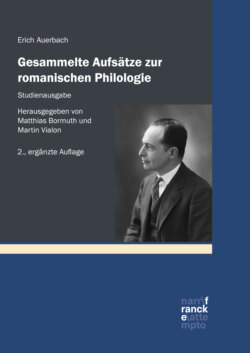Читать книгу Gesammelte Aufsätze zur romanischen Philologie – Studienausgabe - Erich Auerbach - Страница 18
IV. Rahab
ОглавлениеMore than fifty years ago Paget ToynbeeToynbee, P. discovered that Rahab, the harlot in Joshua, chs. 2 and 6, who holds a very distinguished place in the heaven of Venus (Par. 9, 115–126), is to be considered as a type of the Church. He published his discovery, based on passages from IsidorusIsidor v. Sevilla and Petrus ComestorPetrus Comestor, in The Academy of September 12, 1894, p. 216; he also stressed the fact that Rahab is one of the ancestors of Christ (Matth.Matthäus (Evangelist) 1, 5). E. RostagnoRostagno, E. gave an account of Toynbee’s article in Bullettino, II, 94; this account only is available to me at the moment. There cannot be the slightest doubt that Toynbee was right, and that his discovery is indispensable for the understanding of DanteDante’s verses. Nevertheless, it does not seem to have penetrated into all of the important commentaries and commented editions. ZingarelliZingarelli, N. (DanteDante, 3a ed., p. 1205) and H. Flanders DunbarFlanders Dunbar, H. (Symbolism, p. 54) developed it further, and it is recorded in the edition CasiniCasini, T.-BarbiBarbi, M.; but the ninth edition of ScartazziniScartazzini, G. A.-VandelliVandelli, G. (1932) still ignores it. The verses in question are the following:
Tu vuo’ saper chi è in questa lumera
che qui appresso me cosi scintilla,
come raggio di sole in acqua mera.
Or sappi che là entro si tranquilla
Raab; e a nostr’ ordine congiunta,
di lei nel sommo grado si sigilla.
Da questo cielo, in cui l’ombra s’appunta
che’l vostro mondo face, pria ch’altr’alma
del triunfo di Cristo fu assunta.
Ben si convenne lei lasciar per palma
in alcun cielo de l’alta vittoria
che s’acquistò con l’una e l’altra palma,
perch’ella favorò la prima gloria
di Josuè in su la Terra Santa
che poco tocca al papa la memoria.
The book of Joshua, especially its first chapters, has been interpreted from the very earliest times of Christianity as a figure of the appearance of Christ; all the details of the passing over the Jordan and of the conquest of Jericho have entered into the framework of this figura, one of the most famous and popular of Christian Antiquity and the Middle AgesMittelalter. We even possess an illuminated manuscript, the Joshua Roll of the Vatican, executed in the sixth century, probably a copy of the earlier original, which unmistakably shows Joshua as a type of Christ. But already to TertullianTertullian this figurative relation was quite familiar: he explains it in the treatise Adv. Marcionem (3, 16), emphasizing the identity of the names Joshua and Jesus (cf. our note 9). IsidorusIsidor v. Sevilla gives a full description of the details, and his passage concerning Rahab,27 quoted by ToynbeeToynbee, P. and RostagnoRostagno, E., was reproduced or paraphrased many times during the Middle Ages, not only by Petrus ComestorPetrus Comestor in his Historia Scholastica, but also by another author familiar to DanteDante, Petrus DamianiPetrus Damiani,28 who plays a prominent part in the heaven of Saturn (Par. 21). All these ancient commentators say, with slight variations, that the house of Rahab alone with all its inhabitants escaped destruction just as the Church will alone be saved; and that she was freed from the ‘fornication of the world’ by the window of confession, in which she bound the scarlet thread, sanguinis Christi signum. Thus, she became figura ecclesiae, and the scarlet thread (just like the posts struck with the blood of the Lamb, Exod. 12) became a symbol of Christ’s redeeming sacrifice. The conception of Jericho as eternal perdition was supported by the parable from LukeLukas (Evangelist) 10, 30 (homo quidam descendebat ab Jerusalem in Jericho, et incidit in latrones …), generally interpreted as a figure of the fall of man. In the same way, the victory gained con l’una e l’altera palma seems to allude to the victory of Joshua won with outstretched hands (Exod. 17 with Jos. 8; cf. Sir. 46, 1–3), as a figure of the victory of Christ, whose hands were outstretched on the cross.
It has been asked many times whether the alta vittoria for which Rahab stands as a sign is that of Joshua or that of Christ, and the commentators have decided for one or the other possibility. But she stands for both: for the victory of Joshua inasmuch as Joshua figures Christ, for that of Christ inasmuch as Christ ‘fulfills’ Joshua; figuram implere is the term used by the Fathers of the ChurchKirchenväter. Of course, it is the figurative sense which gives to the literal sense its importance and only by the former can the prominent position of Rahab be explained. But both terms of a figurative relation are equally true, equally real, equally present: the figurative sense does not destroy the literal, and the literal does not deprive the figurative of its quality of a real historical event. I have tried to explain this in my above quoted article ‘figura’.
Obviously, the last sentence too, che poco tocca al papa la memoria, is to be understood in a twofold and figurative manner. It is not only the Holy Land in its concrete terrestrial sense, terrena Jerusalem, which the Pope has forgotten by fighting against Christians instead of liberating it; he also, for the sake of the maledetto flore, has lost all memory of our city to come, aeterna Jerusalem.
